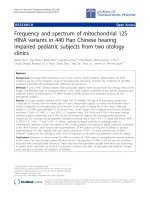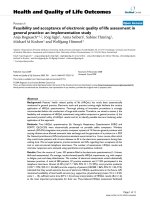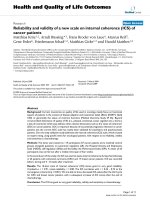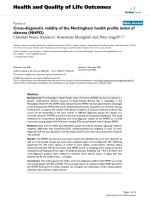báo cáo hóa học: " Reliability and validity of the Spanish version of the 10-item Connor-Davidson Resilience Scale (10-item CD-RISC) in young adults" potx
Bạn đang xem bản rút gọn của tài liệu. Xem và tải ngay bản đầy đủ của tài liệu tại đây (367.64 KB, 6 trang )
SHOR T REPOR T Open Access
Reliability and validity of the Spanish version of
the 10-item Connor-Davidson Resilience Scale
(10-item CD-RISC) in young adults
Blanca Notario-Pacheco
1
, Montserrat Solera-Martínez
1
, María D Serrano-Parra
2
, Raquel Bartolomé-Gutiérrez
3
,
Javier García-Campayo
4
and Vicente Martínez-Vizcaíno
1*
Abstract
Background: The 10-item Connor-Davidson Resilience Scale (10-item CD-RISC) is an instrument for measuring
resilience that has shown good psychometric properties in its original version in English. The aim of this study was
to evaluate the validity and reliability of the Spanish version of the 10-item CD-RISC in young adults and to verify
whether it is structure d in a single dimension as in the original English version.
Findings: Cross-sectional observational study including 681 university students ranging in age from 18 to 30 years.
The number of latent factors in the 10 items of the scale was analyzed by exploratory factor analysis. Confirmatory
factor analysis was used to verify whether a single factor underlies the 10 items of the scale as in the original
version in English. The convergent validity was analyzed by testing whether the mean of the scores of the mental
component of SF-12 (MCS) and the quality of sleep as measured with the Pittsburgh Sleep Index (PSQI) were
higher in subjects with better levels of resilience. The internal consistency of the 10-item CD-RISC was estimated
using the Cronbach a test and test-retest reliability was estimated with the intraclass correlation coefficient.
The C ronbach a coefficient was 0.85 and the test-retest intraclass correlation coefficient was 0.71. The mean MCS score
and the level of quality of sleep in both men and women were significantly worse in subjects with lower resilience scores.
Conclusions: The Spanish version of the 10-item CD-RISC showed good psychometric properties in young adults
and thus can be used as a reliable and valid instrument for measuring resilience. Our study confirmed that a single
factor underlies the resilience construct, as was the case of the original scale in English.
Keywords: Resilience, 10-item CD-RISC, Young adults, Reliability, Validity, Questionnaire
Background
Resilience has been defined as a protective factor against
mental problems and as a dynamic process of adaptation
to changes in life circumstances [1,2]. Various instru-
ments are available for measuring resilience [3,4]. The
Connor-Davidson Resilience Scale (CD-RISC) [5] is a
self-administered scale of 25 i tems that exhib its excel-
lent psychometric properties in young adults [6,7]. Ori-
ginally structured in five dimensions, the factor
structure of the CD-RISC has revealed certain limita-
tions in the multidimensional concept p roposed. For
that reason a new 10-item version was developed, which
resulted in a stable scale with excellent psychometric
properties [6].
As far as the authors know, the psychometric properties
of the Spanish version of the 10-item CD-RISC have not
been evaluated. Therefore, this study aimed to evaluate
the validity and reliability of the Spanish version of the 10-
item CD-RISC in young adults of Cuenca, Spain, in addi-
tion to verifying the single dimension factor structure.
Findings
Study design and population
Cross-sectional, observational study in which were
invited to participate a total of 770 first-year university
students, age 18 to 3 0 years, of the Castile-La Mancha
* Correspondence:
1
Social and Health Care Research Center, University of Castilla-La Mancha,
Cuenca, Spain
Full list of author information is available at the end of the article
Notario-Pacheco et al. Health and Quality of Life Outcomes 2011, 9:63
/>© 2011 Notario-Pacheco e t al; licensee BioMed Central Ltd. This is an Open Access article distributed und er the terms of the Creative
Commons Attribution License ( which permits unrestricted use, distribution, and
reproduction in any medium, provided the original work is properly cit ed.
University in Cuenca campus, Spain. Six hundred
eighty-three (88.7%) students participated in the study
and 681 correctly completed the questionnaires. Stu-
dents who refused to participate in the study were simi-
lar in mean age and sex distribution to participants. We
were unable to ask for the reason for their refusal due
to compulsory indications in this sense of Clinical
Research Ethics Committee.
The study pro tocol was approved by the Clinical
Research Ethics Committee of Hospital Virgen de la Luz
of Cuenca. All the subjects were asked to sign the
informed consent to participate in the study after receiv-
ing oral and written information about the study objec-
tives and procedures.
Measurement variables and instruments
All the subjects were administered a battery of tests to
determine, in addition to the sociodemographic
variables:
- Resilience
This was evaluated using the 10-item CD-RISC [6,8], a
self-administered questionnaire of 10 items designed as
a Likert type additive scale with five response options (0
= never; 4 = almost alw ays), which had a single dimen-
sion in the original version. The final score on the ques-
tionnaire was the sum of the responses obtained on
each item (range 0-40) and the highest scores indicated
the highest level of resilience. In order to defi ne the
final version, the version of the scale translated into
Spanish provided by the authors of the original scale
and was adapted with minimal changes [9].
- Mental health
The Mental Component Summary (MCS) of the SF-12
quality of life questionnaire, adapted and validated in
Castilian Spanish was used [10].
-Quality of sleep
The Pittsburgh Sleep Quality Index (PSQI) [11] is a sim-
ple, short self-administered questionnaire, consisting of
19 questions for the patient and 5 more questions for
the partner, and structured in seven dimensions. Each
dimension was scored from 0 to 3 an d the final score
obtained was 0 to 21. The scale is negative and the
highest s core corresponds t o the worst quality of sleep.
Approved Spanish version was used [12].
Questionnaire administration strategy
Students were convened for meetings in the classrooms
of the respecti ve centers, where the study objectives and
procedures were explained. After the presentation, all
the students who signed the informed consent were
given the questionnaire to complete. Three investigators
were in the classroom while students completed the
questionnaires to avoid contamination b etween the
responses of each one.
Statistical analysis and validation process
Construct validity
Principal components analysis (PCA) was use d to ana-
lyze a number of factors underlying the scale. The Bar-
tlett sphericity test and KMO index were used to assess
the suitability of the factor solution. An eigenvalue of 1
was used as a criterion for factor extraction. A sedimen-
tation graph was used to analyze the suitability of the
number of factors extracted.
The suitability of a single factor model underlying 10-
item CD-RISC was analyzed by confirmatory factor analy-
sis (CFA) with IBM SPSS Amos 19 software . Because of
sex differences in resilience have been descri bed [13], we
tested if the factor structure of r esilience construct was
similar for both men and women, and analyses were per-
formed for each sex and Chi-squared tests were used to
examine differences in factors loadings between the sexes.
As the sample sizes were relatively large (n = 681), the
goodness of fit of the hypo thetical models to the sample
data was assessed with the Hu and Bentler criteria [14].
To test the factor structure of the 10-item CD-RISC,
we splitted the sample into two subsamples randomly
and conducted PCA and CFA using this two sub-sam-
ples respectively.
Convergent validity
The total 10-item CD-RISC score was categorized as:
low resilience (first quartile), moderate resilience (sec-
ond and third quartiles) and high resilience (fourth
quartile). Given that the highest levels of resilience are
associated with better mental health conditions [15] and
that certain mental problems like anxiety and depression
are associated with sleep disorders and less resilience
[11,16], the convergent validity of the scale was ana-
lyzed, by gender, by ANCOVA models using MCS mean
and PSQI mean as dependent variables, 10-item CD-
RISC categories as fixed factors, and age as covariate.
Effect sizes ‘d’ were calculated employing the estimated
marginal means and were interpreted as small (0.20-
0.50), moderate (0.51-0.80) or large (> 0.80) [17].
Reliability
The internal consistency of the scale was evaluated by cal-
culating Cronbach’s alpha coefficient. Test-retest reliability
was examined in a subsample of 95 students selected ran-
domly from all the sample subjects who completed this
questionnaire two times, once when they were convened to
participate in the study and the second time two weeks
later. The tests-retest intraclass correlation coefficient was
used in the reproducibility analysis of the 10-item CD-RISC.
Except for CFA, analyses were perfor med with IBM
SPSS Statistics 19 software [18].
Results
The final sample included 681 first-year university stu-
dents, age range 18 to 30 years (mean = 20.08; SD =
Notario-Pacheco et al. Health and Quality of Life Outcomes 2011, 9:63
/>Page 2 of 6
4.12). Off these, 506 (73.86%) were women, percentage
in accordance with the sex ratio in the University Cam-
pus of Cuenca, Spain. The mean score of 10-item CD-
RISC for the total sample was 27.41 (SD = 6.36); stu-
dents over 25 yea rs showed scores significantly lower
(27.06; SD = 6.36) than students under 25 years (29.86;
SD = 6.52), p < 0.05. Also, the mean score of 10-item
CD-RISC was significantly higher in men (29.47; SD =
5.80) than in women (26.46; SD = 6.43) p < 0.001.
None of the participants obtained a total score of 0 on
the scale (floor effect), and only 2.3% of subjects
obtained the maximum score (ceiling effect).
Construct validity
The factor solution was adequate. The result of the
KMO test was 0.90 and the Barlett sphericity was signif-
icant (c
2
= 2074.7; gl = 45; p = 0.001). Only one factor
showed an eigenvalue greater than 1. This factor
explained 44.1% of the variance. The saturation of each
item on the PCA is presented in Table 1. The sedimen-
tation graph showed a single suitable factor solution
(Figure 1).
Confirmatory factor analysis
(Figure 2: c
2
= 159.4, df = 35, p = 0.001; CFI = 0.939;
and SRMR = 0.041). The single factor model proposed
for the CFA of the 10-item CD-RISC, by sex, is shown
in Figure 3. The model displayed a good fit by sex and
the factor loading show ed no differences between men
and women (Figure 3: c
2
diff = 9.4, df = 9, p = 0.40).
We separated randomly the sample into two groups,
and the PCA and CFA results did not show significant
differences between groups.
Convergent validity
The differences in the mean score of the MCS and in
the mean score of the PSQI by resilience category, con-
trolling for age, by gender, are shown in Table 2. The
quality of sleep in both men and women was
significantly worse in subjects with lower resilience
scores. On the other hand, the score on the MCS was
also significantly lower in both men and women in the
lowest resilience category.
Reliability
The mean correlation between items was 0.37, the low-
est value being 0.20 and the highest value being 0.57.
Table 1 Factor structure of the 10-item CD-RISC
Items Saturation
1. Able to adapt to change 0.843
2. Can deal with whatever comes 0.834
3. Tries to see humorous side of problems 0.836
4. Coping with stress can strengthen me 0.838
5. Tends to bounce back after illness or hardship 0.849
6. Can achieve goals despite obstacles 0.833
7. Can stay focused under pressure 0.845
8. Not easily discouraged by failure 0.851
9. Thinks of self as strong person 0.828
10. Can handle unpleasant feelings 0.843
Cronbach a = 0.854
Figure 1 Sedimentat ion graph of fac tor components of 10-
item CD-RISC.
Figure 2 Factor loading and goodness-of-fi t indexes of one-
factor model for the 10-items CD-RISC factor structure. Total
sample: n = 681; c
2
= 159.4, df = 35, p = 0.001, CFI = 0.94 and
SRMR = 0.041.
Notario-Pacheco et al. Health and Quality of Life Outcomes 2011, 9:63
/>Page 3 of 6
The range of values of the item-total scale score correla-
tion was 0.45 to 0.69. Cronbach’salphawas0.854and
did not increase after eliminating any of the items. The
intraclass correlati on coefficient between the total score
on the first 10-item CD-RISC questionnaire adminis-
tered and the total score on the sca le two we eks later
was 0.711 (95%CI = 0.596-0.798); the Spearman correla-
tion coefficient was 0.73 (Table 3).
Conclusions
The findings of our study confirmed that the Spanish
version of the 10-item CD-RISC show good
psychometric properties and a high level of reliability
and validity in young adults. The findings also con-
firmed a single dimension underlying the 10 items of
the scale.
The reliability of the Spanish version of the 10-item
CD-RISC was simil ar to that of the original versio n
(Cronbach’s a of the original version = 0.85 and of the
Spanish version = 0.85), and the weights in factor analy-
sis w ere within the range of 0.48-0.76 on our sc ale and
within the range of 0.44-0.74 in the original.
The factor structure of the CD-RISC is debated [7,19-21],
and no cons ensus exists regarding the number of factors
composing this scale. It has been observed [22] that elimi-
nating the items that were highly corre lated resulted in a
unidimensional final 10-item scale that was easier to com-
plete and provided essentially the same information as the
25-item version [6]. Our data confirm that a single factor
underlies the resilience construct, as in the original 10-item
CD-RISC version, and suggests that the 10-item CD-RISC
is an unidimensional measure of resilience.
Figure 3 Factor loading and goodness-of-fit indexes for our
single-factor model for the CD-RISC-10 factor structure, by sex.
Men: n = 175; c
2
= 135.8, df = 35, p = 0.001, CFI = 0.82 and SRMR
= 0.073. Women: n = 506; c
2
= 106.4, df = 35, p = 0.001, CFI = 0.95
and SRMR = 0.040.
Table 2 Mean score of the SF-12 mental component and Pittsburgh sleep quality index by resilience category,
controlling for age, by sex
PSQI
Mean (SD)
10-item CD-RISC Low Resilience
(Percentile <25)
Moderate Resilience
(Percentile 25-75)
High Resilience
(Percentile >75)
p Effect size
1-2 1-3 2-3
Men 7.00 (3.31)
n=22
5.58 (2.56)
n = 101
5.40 (3.16)
n=55
0.029 0.48 0.49 0.06
Women 6.99 (3.33)
n = 167
6.22 (2.95)
n = 245
5.86 (2.89)
n=90
0.003 0.24 0.36 0.12
Total 6.99 (3.32)
n = 189
6.03 (2.85)
n = 346
5.69 (2.99)
n = 145
<0.001 0.31 0.41 0.12
MCS
Mean (SD)
10-item CD-RISC Low Resilience
(Percentile <25)
Moderate Resilience
(Percentile 25-75)
High Resilience
(Percentile >75)
p Effect size
1-2 1-3 2-3
Men 39.87 (6.15)
n=22
41.92 (5.07)
n = 100
43.06 (5.78)
n=53
0.013 0.36 0.53 0.21
Women 37.37 (6.14)
n = 166
38.89 (6.41)
n = 240
42.00 (5.57)
n=89
0.001 0.24 0.79 0.52
Total 37.66 (6.18)
n = 188
39.78 (6.20)
n = 340
42.40 (5.65)
n = 142
<0.001 0.34 0.80 0.44
Table 3 Correlation of the test-retest reliability analysis
Test Test Retest
N 681 95 95
Mean (SD) 27.41 (6.36) 27.03 (5.98) 27.74 (5.08)
Mean CD-RISC
P
25
/
75
23/32 22/31 24/32
Cronbach’s alpha 0.854 0.831 0.807
Spearman correlation 0.732*
*p < 0.001
Notario-Pacheco et al. Health and Quality of Life Outcomes 2011, 9:63
/>Page 4 of 6
Sleep disturbances coincide frequently with mental
and/or physical disorders [23,16]. Likewise, different stu-
dies made in adolescents have shown that subjects with
a high level of resilience are less likely to present mental
disorders, interpersonal conflicts, behavior disorders and
poor academic performance [24,25]. A recent study has
found that the variation in the 5HTTPR gene is asso-
ciated with individual differences in resilience [26],
which could predict the appearance of mental health
problems. Our re sults support the convergent validity of
the scale beca use they showed that both the quality of
sleep and the mean score of the MCS worse in both
men and women with lower resilience scores. Other stu-
dies have commonly used posttraumatic stress scales as
measures of convergent validation [5,6]; in our study
was not possible to use these kind of measures because
of the low lifetime prevalence of severe stressful events
at the age of our sample.
Nonetheless, these results should be interpreted with
caution given the limitations of this study. As a cross-
sectional study, the results do not establish predictive
validity between the levels of resilience and the MCS
and the PSQI. Moreover, the sample studied included
only university student, so our results certainly cannot
be extrapolated to the general population. However,
among the strengths of our study it should be noted
that this is the first validation study of the 10-item CD-
RISC in Castilian Spanish, and that this short and sim-
ple instrument requires little time to complete and is
thus efficiently administered. For that reason, it may be
a suitab le instrument for clini cal use and in community
studies.
Acknowledgements
This study was funded mainly by la Fundación para la Investigación Sanitaria
en Castilla-La Mancha (FISCAM) (Ref AN/2008/31). Additional funding was
obtained from the Instituto de Salud Carlos III, Red de Investigación en
Actividades Preventivas y de Promoción de Salud (Ref RD06/0018/0038).
We thank all people that have participated in this research.
Author details
1
Social and Health Care Research Center, University of Castilla-La Mancha,
Cuenca, Spain.
2
Faculty of Nursing, University of Castilla-La Mancha, Cuenca,
Spain.
3
Faculty of Nursing, University of Castilla-La Mancha, Albacete, Spain.
4
Miguel Servet Hospital. University of Zaragoza. Aragon’s Institute of Health
Sciences, Spain.
Authors’ contributions
BNP conceived the study design and contributed to collect the data and to
redact the manuscript. MSM conducted the statistical analysis. MDSP, RBG
and JGC contributed to draft the manuscript. VMV is the main researcher of
the study, and he contributed to conceive the study design, to conduce the
statistical analysis and to redact the manuscript. All authors read and
approved the final manuscript.
Competing interests
The authors declare that they have no competing interests.
Received: 22 March 2011 Accepted: 5 August 2011
Published: 5 August 2011
References
1. Rutter M: Resilience in the face of adversity: protective factors and
resistance to psychiatric disorders. Br J Psych 1985, 147:598-611.
2. Norris FH, Stvens SP, Pfefferbaum B, Wyche KF, Pfefferbaum RL: Community
resilience as a metaphor, theory, set of capacities, and strategy for
disaster readiness. Am J Community Psychol 2008, 41 :127-150.
3. Ahern NR, Kiehl EM, Lou Sole M, Byers J: A review of instruments
measuring resilience. Issues in Comprehensive Pediatric Nursing 2006,
29:103-25.
4. Windle G, Bennett KM, Noye J: A methodological review of resilience
measurement scale. Health and Quality of Life Outcomes 2011, 9:8.
5. Connor KM, Davidson JRT: Development of a new resilience scale: The
Connor-Davidson Resilience Scale (CD-RISC). Depression and Anxiety 2003,
18:76-82.
6. Campbell-Sills L, Stein MB: Psychometric analysis and refinement of the
Connor-Davidson Resilience Scale (CD-RISC): validation of a 10-item
measure of resilience. Journal of Traumatic Stress 2007, 20:1019-28.
7. Singh K, Yu XN: Psychometric evaluation of the Connor-Davidson
Resilience Scale (CD-RISC) in a sample of Indian students. J Psychology
2010, 1:23-30.
8. Wang L, Shi Z, Zhang Y, Zhang Z: Psychometric properties of the 10-item
Connor-Davidson Resilience Scale in Chinese earthquake victims.
Psychiatry and Clinical Neurosciences 2010, 64:499-504.
9. Bobes J, Bascarán MT, García-Portilla MP, Bousoño M, Sáiz PA, Wallance DH:
Banco de instrumentos básicos de psiquiatría clínica. Barcelona:
Psiquiatría ED; 2001.
10. Alonso J, Regidor E, Barrio G, Prieto L, Rodríguez C, de la Fuente L: Valores
poblacionales de referencia de la versión española del Cuestionario de
Salud SF-36. Med Clin Barc 1998, 111:410-416.
11. Buysse DJ, Reynolds CF, Monk TJ, Berman SR, Kupfer DJ: The Pittsburgh
Sleep Quality Index: a new instrument for psychiatric practice and
research. Psychiatric Research 1989, 28:193-213.
12. Macías JA, Royuela A: La versión española del índice de calidad de sueño
de Pittsburgh. Informaciones Psiquiátricas 1996, 146:465-472.
13. Campbell-Sills L, Forde DR, Stein MB: Demographic and childhood
environmental predictors of resilience in a community sample. Journal of
Psychiatric Research 2009, 43:1007-1012.
14. Hu L, Bentler PM: Cutoff criteria for fit indexes in covariance structure
analysis: Conventional criteria versus new alternatives. Structural Equation
Modeling 1999, 6:1-55.
15. Connor KM, Zhang W: Recent advances in the understanding and
treatment of anxiety disorders. Resilience: determinants, measurement,
and treatment responsiveness. CNS
Spectr 2006, 11(Suppl 12):5-12.
16. Carli V, Roy A, Bevilacqua L, Maggi S, Cesaro C, Sarchiapone M: Insomia
and suicidal behaviour in prisioners. Psychiatry research 2011, 185:141-144.
17. Cohen J: Statistical power analysis for the behavioral sciences. New York,
Academic Press;, 2 1988.
18. Byrne BM: Structural equation modeling with AMOS: Basic concepts,
applications and Programming. New York, Taylor and Francis Group;, 2
2010.
19. Yu XN, Lau JTF, Mak WWS, Zhang J, Lui WWS, Zhang J: Factor structure
and psychometric properties of the Connor-Davidson Resilience Scale
among Chinese adolescents. Comprehensive Psychiatry 2011, 52:218-224.
20. Lamond AJ, Depp CA, Allison M, Langer R, Reichstadt J, Moore DJ,
Golshan S, Ganiats TG, Jeste DDV: Measurement and predictors of
resilience among community-dwelling older women. Journal of
Psychiatric Research 2009, 43:148-154.
21. Karaırmak Ö: Establishing the psychometric qualities of the Connor-
Davidson Resilience Scale (CD-RISC) using exploratory and confirmatory
factor analysis in a trauma survivor sample. Psychiatry Res 2010,
179:350-356.
22. Burns RA, Anstey KJ: The Connor-Davidson Resilience Scale (CD-RISC):
testing the invariance of a uni-dimensional resilience measure that is
independent of positive and negative affect. Personality and Individual
Differences 2010, 48:527-531.
23. Taylor DJ, Mallory LJ, Lichstein KL, Durrence HH, Riedel BW, Bush AJ:
Comorbidity of chronic insomnia with medical problems. Sleep 2007,
30:213-218.
24. Rew L, Taylor-Seehafer M, Thomas NY, Yockey RD: Correlates of resilience
in homeless adolescents. J Nurs Scholarsh 2001, 33:33-40.
Notario-Pacheco et al. Health and Quality of Life Outcomes 2011, 9:63
/>Page 5 of 6
25. Wills TA, Sandy JM, Shinar O, Yaeger A: Contributions of positive and
negative affect to adolescents substance use: test of a biodimensional
model in a longitudinal study. Psychol Addict Behav 1999, 13:327-338.
26. Stein MB, Campbell-Sills L, Gelernter J: Genetic variation in 5HTTLPR is
associated with emotional resilience. Am J Med Genet B Neuropsychiatr
Genet 2009, 150B:900-906.
doi:10.1186/1477-7525-9-63
Cite this article as: Notario-Pacheco et al.: Reliability and validity of the
Spanish version of the 10-item Connor-Davidson Resilience Scale (10-
item CD-RISC) in young adults. Health and Quality of Life Outcomes 2011
9:63.
Submit your next manuscript to BioMed Central
and take full advantage of:
• Convenient online submission
• Thorough peer review
• No space constraints or color figure charges
• Immediate publication on acceptance
• Inclusion in PubMed, CAS, Scopus and Google Scholar
• Research which is freely available for redistribution
Submit your manuscript at
www.biomedcentral.com/submit
Notario-Pacheco et al. Health and Quality of Life Outcomes 2011, 9:63
/>Page 6 of 6









